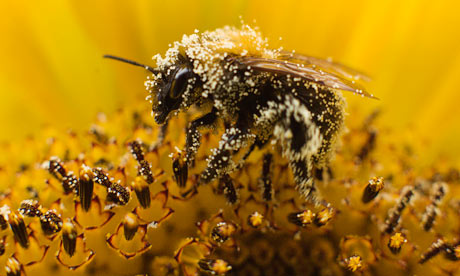Gretchen found this frog sleeping in the okra:
One eye open:
Continue reading
 How long will it take the U.S. to follow Europe’s ban of
neonicotinoid pesticides, putting health of bees and food crop pollination
ahead of corporate profit?
How long will it take the U.S. to follow Europe’s ban of
neonicotinoid pesticides, putting health of bees and food crop pollination
ahead of corporate profit?
Damian Carrington wrote for the Guardian today, Bee-harming pesticides banned in Europe: EU member states vote ushers in continent-wide suspension of neonicotinoid pesticides,
Europe will enforce the world’s first continent-wide ban on widely used insecticides linked to serious harm in bees, after a European commission vote on Monday.
The landmark suspension is a victory for millions of environment campaigners concerned about dramatic declines in bees who were backed by experts at the European Food Safety Authority (EFSA). But it is a serious defeat for the chemical companies who make billions a year from the products and also UK ministers—who voted against the ban. Both had argued the ban will harm food production.
The vote by the 27 member states of the European Union to suspend the insect nerve agents was supported by 15 nations, but did not reach the required majority under EU voting rules. The hung vote hands the final decision to the European commission (EC) who will implement the ban. “It’s done,” said an EC source.
-jsq
 Nature is not something
out there, apart from people.
It never was, and nowadays people have built and farmed and clearcut
so much that wildlife species from insects to birds are in trouble.
In south Georgia people may think that our trees make a lot of wildlife habitat.
Actually, most of those trees are planted pine plantations with
very limited undergrowth, and in town many yards are deserts of grass
plus exotic species that don’t support native birds.
Douglas Tallamy offers one solution:
turn yards into wildlife habitat by growing native species.
Since we are as always remodeling nature, we might as well do it
so as to feed the rest of nature and ourselves,
and by the way get flood prevention and possibly cleaner water as well,
oh, and fewer pesticides to poison ourselves.
Nature is not something
out there, apart from people.
It never was, and nowadays people have built and farmed and clearcut
so much that wildlife species from insects to birds are in trouble.
In south Georgia people may think that our trees make a lot of wildlife habitat.
Actually, most of those trees are planted pine plantations with
very limited undergrowth, and in town many yards are deserts of grass
plus exotic species that don’t support native birds.
Douglas Tallamy offers one solution:
turn yards into wildlife habitat by growing native species.
Since we are as always remodeling nature, we might as well do it
so as to feed the rest of nature and ourselves,
and by the way get flood prevention and possibly cleaner water as well,
oh, and fewer pesticides to poison ourselves.
Douglas Tallamy makes a clear and compelling case in
 Bringing Nature Home: How You Can Sustain Wildlife with Native Plants
Bringing Nature Home: How You Can Sustain Wildlife with Native Plants
…it is not yet too late to save most of the plants and animals that sustain the ecosystems on which we ourselves depend. Second, restoring native plants to most human-dominated landscapes is relatively easy to do.
Some of you may wonder why native species are so important? Don’t we have more deer than we can shoot? Maybe so, but we have far fewer birds of almost every species than we did decades and only a few years ago.
Some may wonder: aren’t exotic species just as good as native ones,
if deer and birds can eat them?
Actually, no, because many exotic species are poisonous
 to native wildlife, and because invasive exotics crowd out natives
and reduce species diversity.
From kudzu to
Japanese climbing fern, exotic invasives are bad for wildlife
and may also promote erosion and flooding by strangling native vegetation.
to native wildlife, and because invasive exotics crowd out natives
and reduce species diversity.
From kudzu to
Japanese climbing fern, exotic invasives are bad for wildlife
and may also promote erosion and flooding by strangling native vegetation.
All plants are not created equal, particularly in their ability to support wildlife. Most of our native plant-eaters are not able to eat alien plants, and we are replacing native plants with alien species at an alarming rate, especially in the suburban gardens on which our wildlife increasingly depends. My central message is that unless we restore native plants to our suburban ecosystems, the future of biodiversity in the United States is dim.
Tallamy had an epiphany when he and his wife moved to 10 acres in Pennsylvania in 2000:
Continue reading